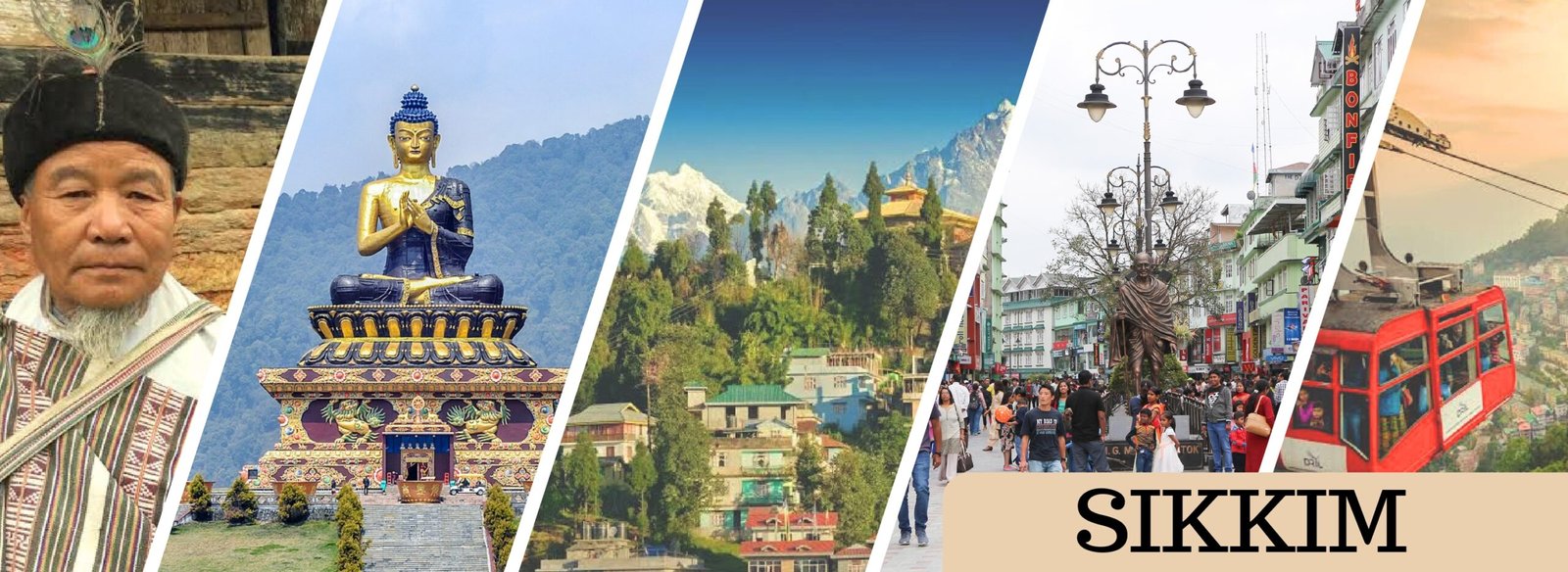Sikkim, nestled in the eastern Himalayas, is one of India’s most enchanting states. Known for its pristine landscapes, rich cultural heritage, and biodiversity, Sikkim stands out as a unique blend of natural beauty and cultural richness. This essay delves into Sikkim’s geographical features, cultural and demographic diversity, economic activities, historical heritage, and tourism potential.
Sikkim is bordered by Tibet to the north and northeast, Bhutan to the east, Nepal to the west, and the Indian state of West Bengal to the south. The state’s terrain is predominantly mountainous, with the majestic Kanchenjunga, the third-highest peak in the world, towering at 8,586 meters. Sikkim’s geography is characterized by its rugged landscape, deep valleys, and numerous rivers, including the Teesta and Rangeet.
The state enjoys a temperate climate, with alpine weather in the higher altitudes and subtropical conditions in the lower regions. This diverse topography supports a wide range of flora and fauna, making Sikkim a biodiversity hotspot. The state’s lush green forests, cascading waterfalls, and serene lakes contribute to its stunning natural beauty.
Sikkim is home to a diverse population, comprising various ethnic groups, including the Lepchas, Bhutias, and Nepalese. Each community has its distinct language, customs, and traditions, which collectively contribute to the state’s rich cultural tapestry. The primary languages spoken are Nepali, Bhutia, and Lepcha, while English and Hindi are also widely understood and used for official communication.
The state’s cultural diversity is reflected in its festivals, dances, music, and traditional practices. The Lepchas, considered the original inhabitants, have a unique cultural heritage, closely tied to nature and the environment. The Bhutias, of Tibetan descent, brought with them Buddhist traditions and customs, while the Nepalese introduced various Hindu practices.
Sikkim’s economy is primarily agrarian, with agriculture being the mainstay. The state’s fertile valleys support the cultivation of crops such as rice, maize, millet, and cardamom. Sikkim is known for its organic farming practices, and in 2016, it became the first fully organic state in India. The state’s organic produce, including ginger, turmeric, and various vegetables, is highly valued both domestically and internationally.
Horticulture is another significant sector, with the cultivation of fruits like oranges, apples, and plums gaining prominence. Sikkim is also known for its production of flowers, particularly orchids and gladioli, which contribute to its economy. Tourism is a rapidly growing sector, driven by the state’s natural beauty, adventure opportunities, and cultural attractions.
Sikkim has a rich historical heritage shaped by its indigenous tribes and its strategic location in the Himalayas. The region was ruled by the Namgyal dynasty from the 17th century until it became a part of India in 1975. The Namgyal rulers were of Tibetan origin and played a significant role in spreading Buddhism in the region. The state’s historical legacy is reflected in its ancient monasteries, palaces, and traditional governance systems.
Buddhism has had a profound influence on Sikkim’s history and culture, with numerous monasteries, including the famous Rumtek and Pemayangtse Monasteries, serving as centers of religious and cultural activities. The state’s historical connections with Tibet and its role as a buffer state between major powers have contributed to its unique cultural and political heritage.
Sikkim’s cultural heritage is vibrant and diverse, with traditional music, dances, and festivals playing a central role. The state’s festivals are a reflection of its rich cultural tapestry, with each community celebrating its unique traditions and rituals. Some of the most notable festivals include Losar, Saga Dawa, and Pang Lhabsol.
Losar, the Tibetan New Year, is one of the most important festivals in Sikkim, celebrated with great enthusiasm by the Bhutia community. It involves traditional rituals, dances, and feasts, marking the beginning of the lunar new year. Saga Dawa, a significant Buddhist festival, celebrates the birth, enlightenment, and death of Lord Buddha, with processions, prayers, and religious ceremonies.
Pang Lhabsol, unique to Sikkim, commemorates the consecration of Mount Kanchenjunga as the guardian deity of the state. It includes traditional dances, prayers, and rituals performed by monks, symbolizing the unity and harmony among the people of Sikkim. The state’s traditional dances, such as the Mask Dance (Chaam) and the Lepcha dance, are integral to its cultural identity.
Sikkim’s stunning landscapes, rich cultural heritage, and tranquil environment make it an attractive destination for tourists. The state’s numerous natural attractions, adventure opportunities, and unique cultural experiences draw visitors seeking both serenity and excitement.
Gangtok: The capital city of Sikkim, Gangtok, is perched on a ridge overlooking the Ranipool River. It offers panoramic views of the surrounding hills and the distant Kanchenjunga. Key attractions include the Enchey Monastery, Tashi Viewpoint, and MG Marg, a bustling street with shops and restaurants.
Nathula Pass: Located on the Indo-China border, Nathula Pass is a historic trade route and a popular tourist destination. It offers stunning views of the surrounding mountains and is accessible from Gangtok via a scenic drive.
Tsomgo Lake: A glacial lake situated at an altitude of 3,753 meters, Tsomgo Lake is known for its serene beauty and is a popular destination for tourists. The lake is surrounded by snow-capped mountains and is considered sacred by the locals.
Rumtek Monastery: One of the most significant monasteries in Sikkim, Rumtek Monastery is the seat of the Karmapa Lama, the head of the Karma Kagyu lineage of Tibetan Buddhism. The monastery is known for its beautiful architecture and serene ambiance.
Yumthang Valley: Known as the “Valley of Flowers,” Yumthang Valley is a picturesque destination located in North Sikkim. It is home to numerous species of flowers, including rhododendrons, primulas, and poppies, and offers breathtaking views of the surrounding mountains.
Pelling: A charming town in West Sikkim, Pelling is known for its stunning views of Kanchenjunga and its numerous attractions, including the Pemayangtse Monastery, Rabdentse Ruins, and the Khecheopalri Lake.
Festivals in Sikkim are a reflection of its cultural richness and community spirit. Some of the notable festivals include:
Losar: Celebrated by the Bhutia community, Losar marks the Tibetan New Year and involves traditional rituals, dances, and feasts.
Saga Dawa: A significant Buddhist festival, Saga Dawa celebrates the birth, enlightenment, and death of Lord Buddha with processions, prayers, and religious ceremonies.
Pang Lhabsol: Unique to Sikkim, Pang Lhabsol commemorates the consecration of Mount Kanchenjunga as the guardian deity of the state and includes traditional dances, prayers, and rituals performed by monks.
Sikkim, with its stunning natural landscapes, rich cultural heritage, and diverse traditions, truly embodies the “Jewel of the Himalayas.” The state’s geographical features, including its towering peaks, deep valleys, and lush forests, contribute to its unique ecological wealth. Sikkim’s economy, driven by agriculture, horticulture, and tourism, plays a crucial role in its development.
br>
The state’s cultural diversity, historical significance, and vibrant festivals add to its allure, making it a fascinating destination for tourists. As Sikkim continues to develop and preserve its heritage, it stands as a testament to India’s cultural and natural diversity. The state’s potential as a major tourist destination is immense, offering a unique experience to visitors and contributing to its sustainable growth.







